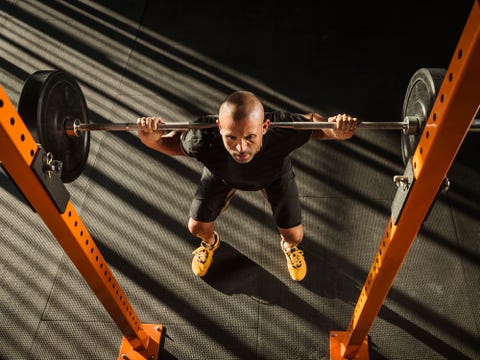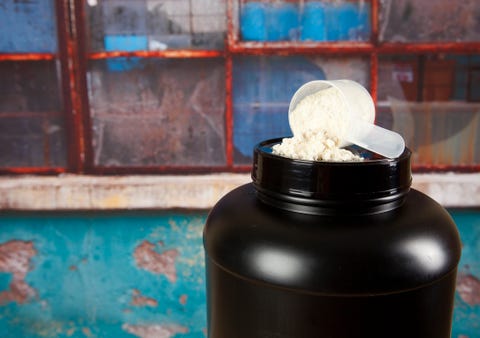Ask any guy if he wants to be able to lift heavier, and the odds that he’ll say yes are high.
Just like running faster, being able to pick up more weight on a consistent basis just feels pretty badass. Not to mention there are plenty of total-body benefits you’ll see along with serious strength gains, from better overall heart health and potential reduction in depressive symptoms.
The science doesn’t stop there, either. Those who lift heavy typically see more progress in their strength over a shorter period of time—even when muscle mass is equal to those who lift lighter, according to research. When you lift heavy, you’re also conditioning your nervous system even more effectively, meaning that it will require less effort for your muscles to lift or exert force than someone who uses lighter weights, according to research published in Frontiers of Physiology.
So the big question: how? Here, top trainers give us their hacks for lifting heavier in the gym and channeling your inner Rich Froning (we promise, he’s in there somewhere).
Practice Makes Perfect
“With any skill, deliberate practice is the best way to get better,” says Denzel Allen, Strongfirst trainer in San Francisco. “If you view building strength as building a skill, that should change your mindset and approach completely.”
This means that it starts with mastering a movement before overloading it. Want to back squat 300 pounds like it’s nothing? Make sure you have the squat mechanics down, first. (If that’s actually the exercise you’re looking to load up on, check out this form check.)
“By working with loads you are sure you can handle, you’ll be in a better place to build strength,” says Allen. “This ensures that every rep is as close to perfection as possible, teaching your body only success, not failure.”
Make Time To Warm Up
And that doesn’t mean you halfheartedly step through a few lunges or bodyweight squats, either. During your warm-up—which should always be dynamic or fluid—make sure you’re prepping all of the joints that you’re planning to utilize throughout your workout.
“Yes, foam rolling can help, using a hard implement (LAX ball, hard roller, etc.) even better; but truly mobilizing a joint requires controlled, dynamic (not static for strength) stretching,” says Austin Lopez, C.S.C.S. “You want to stretch not just the muscles connecting across joints, but also the fascia encasing the muscle, through the fat tissue, and connecting to the skin at a challenging range, creating new ranges of motion that can hold weight at range.”
Having a lot of trouble getting yourself mobile? News flash: If a muscle can’t stretch correctly, it likely can’t be used or stimulated correctly, says Lopez. That could result in injury, so don’t push your luck. If you have real issues moving, consider working with a coach or even talking to a physical therapist about the problem.
Make Time to Train Often

Erik IsaksonGetty Images
If you want to lift heavier, you need to be willing to commit. Big progress one day doesn’t always mean huge gains the next. “Muscles can begin to atrophy as early as a week after being worked,” says Lopez. “I recommend not going much more than that before hitting a muscle group you want to get bigger.”
Lopez suggests working muscle groups shortly after they have healed (when the worst of any soreness is gone or nearly gone) to produce the largest strength gains. “You want the muscles to be overloaded regularly, so that they can rebuild to produce stronger cells on top of the other strengthened cells,” he says.
Turn Up the Tension
“Our body works as a unit,” explains Allen. “The tighter we clench our fist, root our feet into the floor, get more muscles involved in general, the stronger we can be.”
Take a barbell overhead press for example. Doing this press without ‘turning things on’—keeping your legs soft, not engaging your core, taking a weak grip—makes finishing through solid reps feel more difficult. If you were to drive your feet into the floor, squeeze your glutes tight, white knuckle the bar and tense your trunk, those reps would feel totally different, according to Allen.
“I bet you the weight will fly up overhead with far more ease,” he says. “Having the ability to relax and create tension are some of the greatest tricks we can work on to build strength.”
Fuel Smart

jorgegonzalezGetty Images
You hear it time and time again: the way that you fuel your body is just as important as what you’re doing in the weight room. “The fastest way to put on muscle is to stimulate and feed it,” says Lopez.
You want to be consuming at least .7 grams of protein per pound of bodyweight—and that can come from a variety of sources. One 2019 study shows that whether you get your protein from whey or actual milk, the amount of muscle weight you gain will be much the same. Since whey protein supplements are easy to take, however, we’d recommend starting your protein intake there. If you’re really looking to overhaul your meal plan, check out these tips, too.
Source: Read Full Article
